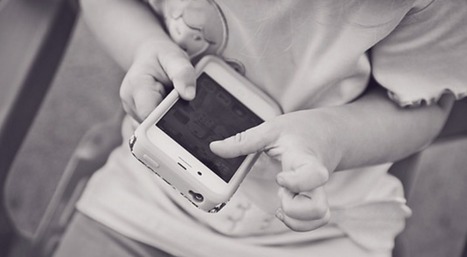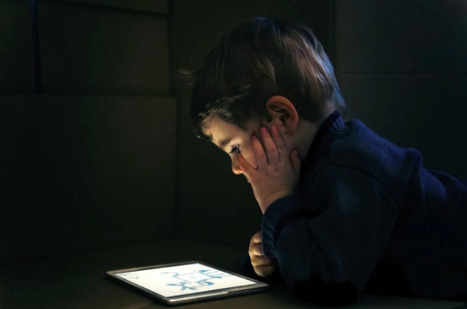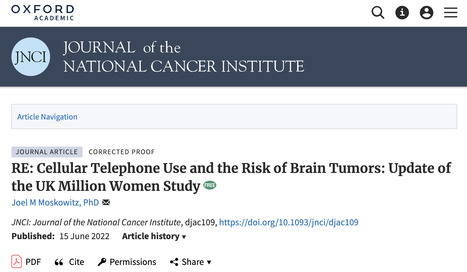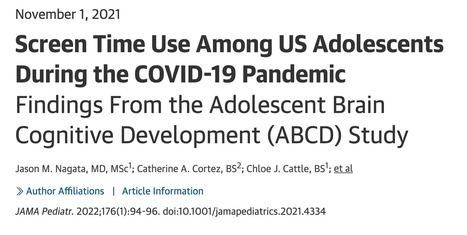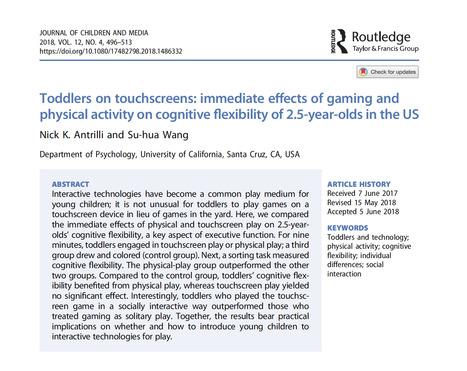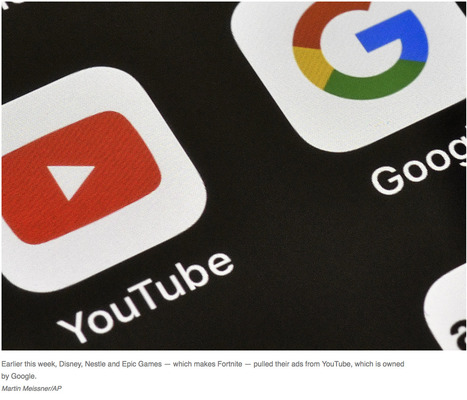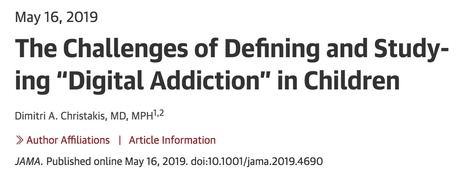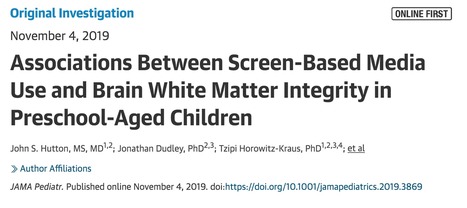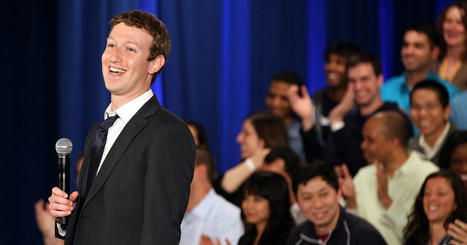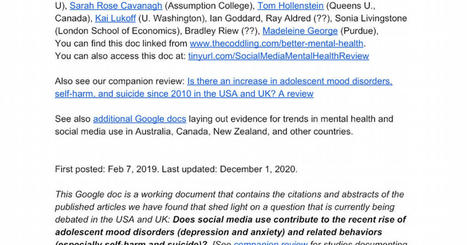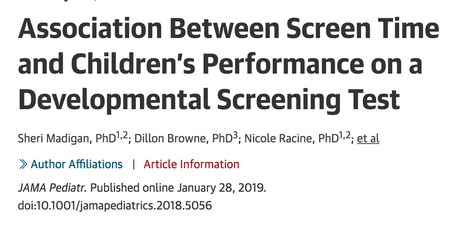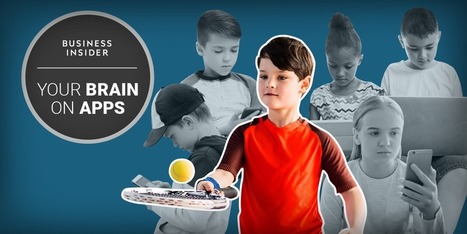
|
Scooped by
Roxana Marachi, PhD
onto Screen Time, Tech Safety & Harm Prevention Research March 30, 2019 10:10 AM
|
Get Started for FREE
Sign up with Facebook Sign up with X
I don't have a Facebook or a X account

 Your new post is loading... Your new post is loading...
 Your new post is loading... Your new post is loading...
"The American Academy of Pediatrics has recently issued two new sets of recommendations on media use for children. At first glance, popular news headlines suggest elimination of the previous “no screens before age two” recommendations (see NPR’s American Academy of Pediatrics Lifts ‘No Screens Under 2’ Rule and KQED’s American Academy of Pediatrics Says Some Screen Time is Okay for Kids Under Two). However, close examination of the new guidelines reveal nuanced suggestions that maintain a primary focus on limiting tech usage. What appear to be obscured in public discussions are the same AAP organization’s recommendations issued just months earlier, specifically encouraging parents to reduce children’s exposures to cell phone radiation. For ease of access, both sets of recommendations are provided in this post. “Healthy Digital Media Use Habits for Babies, Toddlers & Preschoolers The American Academy of Pediatrics (AAP) encourages you to help your children develop healthy media use habits early on. Read on to learn more.”…
Digital books (“eBooks”) that have lots of sound and visual effects can sometimes distract children, who then “miss the story” and don’t learn as well as they would from a print book. If you plan to read e-books to your children:
Why Limit Media Use?
Other Tips for Parents, Families, and Caregivers
Additional Information from HealthyChildren.org (American Academy of Pediatrics)
The related recommendations below on cell phone use were issued by the same American Academy of Pediatrics, yet appear to be receiving much less media attention. American Academy of Pediatrics Issues New Recommendations to “Reduce Exposure to Cell Phones”: Nation’s largest group of children’s doctors responds to new government study linking cell phone radiation to cancer. “In response to the U.S. National Toxicology Program study results finding exposure to wireless radiation significantly increased the prevalence of highly malignant heart and brain cancers in rodents, the American Academy of Pediatrics (AAP) has issued specific recommendations to reduce wireless cell phone exposure and updated their online resources for parents concerning cell phones and wireless devices. “They’re not toys. They have radiation that is emitted from them and the more we can keep it off the body and use (the phone) in other ways, it will be safer,” said Jennifer A. Lowry, M.D., FAACT, FAAP, chair of the AAP Council on Environmental Health Executive Committee in the AAPs press release on the NTP Study Results. “The findings of brain tumors (gliomas) and malignant schwann cell tumors of the heart in the NTP study, as well as DNA damage in brain cells, present a major public health concern because these occurred in the same types of cells that have been reported to develop into tumors in epidemiological studies of adult cell phone users,” stated Ronald L. Melnick, PhD, the National Institutes of Health toxicologist who lead the NTP study design and senior advisor to the Environmental Health Trust. “For children the cancer risks may be greater than that for adults because of greater penetration and absorption of cell phone radiation in the brains of children and because the developing nervous system of children is more susceptible to tissue-damaging agents. Based on this new information, regulatory agencies need to make strong recommendations for consumers to take precautionary measures and avoid close contact with their cell phones, and especially limit or avoid use of cell phones by children.” The AAP has updated their Healthy Children Webpage on Cell Phones entitled Cell Phone Radiation & Children’s Health: What Parents Need to Know. The webpage reiterated children’s unique vulnerability to cell phone radiation stating, “Another problem is that the cell phone radiation test used by the FCC is based on the devices’ possible effect on large adults—not children. Children’s skulls are thinner and can absorb more radiation.” The AAP issued the following cell phone safety tips specifically to reduce exposure to wireless radiation:
Even though the cell phone manual contains specific instructions that say do not carry the phone next to the body, the US government does not publicize this information nor mandate companies inform the public, leaving most people unaware of potential hazards, unwittingly allowing their young children to play with them like toys,” stated Devra Davis MPH, PhD, president of the Environmental Health Trust pointing to the Berkeley Cell Phone Right To Know Ordinance being challenged in court this month. In 2012, the AAP published Pediatric Environmental Health, 3rd Edition recommending, “exposures can be reduced by encouraging children to use text messaging when possible, make only short and essential calls on cellular phones, use hands free kits and wired headsets and maintain the cellular phone an inch or more away from the head.” Since 2012, the AAP has supported the Federal Cell Phone Right to Know Legislation and has written letters to the FCC calling on the federal government to review and strengthen radiation standards for wireless devices in an effort to protect children’s health. Links 2012 AAP Letter in Support of the Cell Phone Right to Know Act _____________________ ##
For main post on EduResearcher, see: https://eduresearcher.com/2016/10/25/media/
"Abstract This study aimed to compare the mean scores of mobile phone use, mobile phone addiction, and depressive symptoms at three-time points among Korean adolescents according to gender and to examine the differences in the long-term relationships among the three above mentioned variables between Korean boys and girls in a four-year period. Data for 1794 adolescents (897 boys and 897 girls) were obtained from three waves of the second panel of the Korean Children and Youth Panel Survey. Multi group structural equation modeling was used for data analyses. KEYWORDS:Korean adolescents; depression; mobile phone addiction; mobile phone use
For original research study, please visit:
"Abstract
For access to original research, please visit:
By Serge Egelman "When parents download a learning or gaming app from the “Designed for Families” section of the Google Play store, they likely assume that those apps keep their kids’ data safe. After all, the Children’s Online Privacy Protection Act (COPPA) prohibits website operators and app developers from tracking or collecting personal data from children under the age of 13. Yet that assumption could be wrong. More than 50 percent of Google Play apps targeted at children under 13—we examined more than 5,000 of the most popular (many of which have been downloaded millions of times)—appear to be failing to protect data. In fact, the apps we examined appear to regularly send potentially sensitive information—including device serial numbers, which are often paired with location data, email addresses, and other personally identifiable information—to third-party advertisers. Over 90 percent of these cases involve apps transmitting identifiers that cannot be changed or deleted, like hardware serial numbers—thereby enabling long-term tracking. To test app privacy, we created an automated test bed that allows us to download and install apps to a series of mobile devices, simulate the behavior of users (with limited additional testing by humans), and then monitor the traffic flowing in and out of the devices. By monitoring an app for just 10 minutes, we can tell whether it tracks the user’s behavior, discloses this tracking, or shares personal data directly with third parties. (Our test bed is limited to Android apps for the sole reason that the Android platform is open source.) Members of my group decided to contact one developer of several apps with particularly egregious practices, all targeted at children under 13. We observed that many of its apps were sending a wide range of persistent identifiers and location data to an advertising and analytics firm. When we reached out to the company, it thanked us and indicated it was previously unaware of the problem. The company said it had removed the advertising firm's computer code from all its games. We reanalyzed several of its apps and confirmed that this was the case. Thus, for at least this developer, it appears as though invasive privacy practices were due to misuse of third-party code. We suspect that most of the developers whose apps fail to protect data do not have nefarious intent, but rather fail to configure their software properly or neglect to scrutinize practices of the third-party advertisers they rely upon to generate revenue. When building an app, developers import ready-to-use code from many different third-parties, including advertising companies. While this code “reuse” results in time savings and fewer errors, app developers likely do not realize that they are liable for all code included in their apps, regardless of whether or not they were the ones who wrote it."...
For full post, see:
Serge Egelman is research director of the Usable Security & Privacy group at the International Computer Science Institute and an affiliated researcher at the University of California, Berkeley Center for Long-Term Cybersecurity.
See AppCensus privacy analysis tool at: http://AppCensus.mobi
"Like the Danish Cohort study (1), the recent article by Schüz et al. (2), which examined cellular telephone use and brain tumor risk in the Million Women Study, suffered from poor exposure assessment that likely contributed to exposure misclassification. Moreover, participant attrition in this study was high (68%), and the study was underpowered; the analysis sample included few participants with heavier cell phone use, the group with the greatest brain tumor risk (2). Only 18% of cell phone users talked on cell phones 30 or more minutes per week (approximately 4 min/d or 26 h/y) (2). Not “more than 3%” of cell phone users had cumulative call time of 1640 or more hours, the top decile of cell phone use in the 13-nation Interphone Study (3), the only subgroup for which there was statistically significantly greater brain tumor risk.
Other methodological limitations of the study include failure to control for cordless phone use, a potential confounder, and failure to control for hands-free cell phone use, which reduces brain tumor risk from microwave radiation exposure by keeping cell phones away from the head during calls (4). Although the Schüz et al. (2) article provides sound advice to “reduce unnecessary exposures,” the abstract in this article is a disservice to public health because it ends with a misleading assertion: “Our findings support the accumulating evidence that cellular telephone use under usual conditions does not increase brain tumor incidence.” How can the authors of this article argue that their results apply to “usual conditions” when the amount of cell phone use in their analysis sample was much less than “usual” for the United Kingdom? According to cellular industry estimates, in 2011 the average mobile phone subscriber in the United Kingdom had 126 minutes of call time per month for outgoing calls (29 min/wk or 4.1 min/d) (5). This is a conservative estimate of overall call time because it does not account for incoming calls. In the United States, call time was approximately 3 times greater than in the United Kingdom (5). This assertion is also problematic because a recent meta-analysis of 46 case-control studies (6) found statistically significantly increased brain tumor incidence with cumulative call time of 1000 or more hours (approximately 17 min/d over a 10-year period). Furthermore, Philips et al. (7) examined brain tumor incidence in England from 1995 to 2015 and found a twofold increase in the standardized incidence of the most common malignant brain tumor, glioblastoma multiforme, along with reduced incidence of lower-grade brain tumors, which could indicate a tumor promotion effect from the increased uptake in cell phone use during this time period. In sum, the Schüz et al. (2) study provides no assurance of safety from brain tumors for most cell phone users, especially those who start using cell phones at a younger age than the middle-aged and elderly women who participated in this study." https://academic.oup.com/jnci/advance-article/doi/10.1093/jnci/djac109/6608754
Abstract
Abstract
https://www.tandfonline.com/doi/abs/10.1080/17482798.2018.1486332
Wireless radiation absorption in child vs adult brain & eye from cell phone conversation or virtual reality // Fernandez C, de Salles AA, Sears ME, Morris RD, Davis DL. Absorption of wireless radiation in the child versus adult brain and eye from cell phone conversation or virtual reality. Environmental Research. Jun 5, 2018. https://doi.org/10.1016/j.envres.2018.05.013 Highlights • More cell phone radiation is absorbed by children's inner brain tissues than adults’. • Children's radio-frequency radiation exposure should be reduced. • Further research to evaluate the risks to the eye from use of VR is urgently needed. • It is biologically relevant and feasible to reduce the standards’ averaging volume. • Current methods to determine wireless device compliance should be revised. Abstract Children's brains are more susceptible to hazardous exposures, and are thought to absorb higher doses of radiation from cell phones in some regions of the brain. Globally the numbers and applications of wireless devices are increasing rapidly, but since 1997 safety testing has relied on a large, homogenous, adult male head phantom to simulate exposures; the “Standard Anthropomorphic Mannequin” (SAM) is used to estimate only whether tissue temperature will be increased by more than 1 Celsius degree in the periphery. The present work employs anatomically based modeling currently used to set standards for surgical and medical devices, that incorporates heterogeneous characteristics of age and anatomy. Modeling of a cell phone held to the ear, or of virtual reality devices in front of the eyes, reveals that young eyes and brains absorb substantially higher local radiation doses than adults’. Age-specific simulations indicate the need to apply refined methods for regulatory compliance testing; and for public education regarding manufacturers' advice to keep phones off the body, and prudent use to limit exposures, particularly to protect the young. [Excerpts] "In summary, compared with adult models, children experience two- to three-fold higher RF doses to: 1) localized areas of the brain when a cell phone is positioned next to the ear; and 2) the eyes and frontal lobe when a cell phone is used to view virtual reality. These findings raise serious questions about the current approach to certify cell phones; particularly the use of the SAM. " "Our modeling demonstrates clearly that localized psSAR varies significantly for critical components of the brain. Younger models absorb proportionally more radiation in the eyes and brain – grey matter, cerebellum and hippocampus—and the local dose rate varies inversely with age. This reflects the fact that the head is not homogeneous. Indeed, localized heating up to 5 Centigrade degrees has been detected as a result of mobile phone radiation studied ex vivo in cow brain using Nuclear Magnetic Resonance thermometry (Gultekin and Moeller, 2013)." "Our findings support reexamination of methods to determine regulatory compliance for wireless devices, and highlight the importance of precautionary advice such as that of American Academy of Pediatrics (2016). The Academy recommends that younger children should not use cell phones, and that prudent measures should be taken to eliminate exposure (e.g. using devices for amusement or education only when all wireless features are turned off – in “airplane mode”) or to minimize exposure (e.g. texting or using speakerphone), and that cell phones should not be kept next to the body. Use of wires/cables in schools and homes circumvents needless exposures of children to radiation from both devices and Wi-Fi routers. There is also an urgent need for research to evaluate the risks to the eye from use of cell phones in virtual reality applications."
By Dwight Akerman, OD, MBA, FAAO
While school closures may be short-lived, increased access, adoption and dependence on digital devices could have a long-term negative impact on childhood development, they warn. Raising awareness among parents, children, and government agencies is key to mitigating myopigenic behaviors that may become entrenched during this period.
They suggest that there is a possibility that a prolonged battle against the COVID-19 virus may lead to an increase in the incidence of myopia by shaping long-term behavioral changes conducive for the onset and progression of myopia. The researchers conclude that while it is vital to adopt strict measures (e.g., lockdown and home quarantine) to slow or halt the spread of COVID-19, multidisciplinary collaborations and close partnerships between ministries, schools, and parents are necessary to minimize the long-term collateral impact of COVID-19-related policies on various health outcomes such as myopia, which was already a significant public health concern before the pandemic.
Abstract Digital Screen Time During COVID-19 Pandemic: Risk for a Further Myopia Boom? Chee Wai Wong, Andrew Tsai, Jost B. Jonas, Kyoko Ohno-Matsui, James Chen, Marcus Ang, Daniel Shu Wei Ting Purpose: To review the impact of increased digital device usage arising from lockdown measures instituted during the COVID-19 pandemic on myopia and make recommendations for mitigating potential detrimental effects on myopia control. Methods: Review of studies focused on digital device usage, near work, and outdoor time in relation to myopia onset and progression. Public health policies on myopia control, recommendations on screen time, and information pertaining to the impact of COVID-19 on increased digital device use were presented. Recommendations to minimize the impact of the pandemic on myopia onset and progression in children were made. Results: Increased digital screen time, near work, and limited outdoor activities were found to be associated with the onset and progression of myopia and could potentially be aggravated during and beyond the COVID-19 pandemic outbreak period. While school closures may be short-lived, increased access, adoption and dependence on digital devices could have a long-term negative impact on childhood development. Raising awareness among parents, children, and government agencies is key to mitigating myopigenic behaviors that may become entrenched during this period. Conclusions: While it is important to adopt critical measures to slow or halt the spread of COVID-19, close collaboration between parents, schools, and ministries is necessary to assess and mitigate the long-term collateral impact of COVID-19 on myopia management policies. Wong, Chee Wai, et al. “Digital Screen Time During COVID-19 Pandemic: Risk for a Further Myopia Boom?.” American Journal of Ophthalmology (2020). https://www.ajo.com/article/S0002-9394(20)30392-5/fulltext
To download slides, click on title or arrow above.
http://www.commercialfreechildhood.org/action/tell-fisher-price-no-ipad-bouncy-seats-infants
The Silicon Valley Billionaires Remaking America's Schools
Dr. Catherine Steiner-Adair
Video link may be viewed at: https://youtu.be/pjnFPo_mk6s
Carter B, Rees P, Hale L, Bhattacharjee D, Paradkar MS. Association Between Portable Screen-Based Media Device Access or Use and Sleep Outcomes: A Systematic Review and Meta-analysis.JAMA Pediatr. 2016 Oct 31. doi: 10.1001/jamapediatrics.2016.2341. [Epub ahead of print] https://www.ncbi.nlm.nih.gov/pubmed/27802500?dopt=Abstract
Screen Time Hurts More Than Kids' Eyes http://www.healthline.com/health-news/screen-time-hurts-more-than-kids-eyes-101215
New Media Consortium / Consortium for School Networking Horizon Report
"American Revolution 2.0: How Education Innovation is Going to Revitalize America and Transform the U.S. Economy" http://sco.lt/5JnF7B
"Preschool is Good For Children But It's Expensive So Utah Is Offering It Online" https://www.washingtonpost.co m/local/education/preschool-is- good-for-poor-kids-but-its- expensive-so-utah-is-offering-it- online/2015/10/09/27665e52- 5e1d-11e5-b38e- 06883aacba64_story.html
Philanthropy Roundtable's: "Blended Learning: Wise Givers Guide to Supporting Tech-Assisted Learning" http://www.philanthropyroundtable.org/file_uploads/Blended_Learning_Guidebook.pdf (Formerly chaired by B. DeVos)
CyberCharters Have Overwhelming Negative Impact http://blogs.edweek.org/edweek/DigitalEducation/2015/10/CREDO_online_charters_study.html
Virtual and Blended Learning Schools Continue to Struggle and Grow http://nepc.colorado.edu/newsletter/2016/04/virtual-schools-annual-2016
ACLU: Guyette: How the EAA's Buzz Program Exploited Detroit's Most Vulnerable Kids http://www.aclumich.org/article/guyette-how-eaas-buzz-program-exploited-detroits-most-vulnerable-kids
Ma, J., van den Heuvel, M., Maguire, J., Parkin, P., Birken, C. (2017). Is handheld screen time use associated with language delay in infants? Presented at the Pediatric Academic Societies Meeting, San Francisco, CA. https://www.sciencedaily.com/releases/2017/05/170504083141.htm
Jonathan Rochelle’s GSV/ASU PRIMETIME Keynote Speech pitching Google Cardboard for children in schools as proxy for actual field trips: https://www.youtube.com/watch?v=YNqYMI89umE
Scientists Urge Google to Stop Untested Microwave Radiation of Children's Eyes and Brains with Virtual Reality Devices in Schools http://sco.lt/8ZY5Zp // https://drive.google.com/file/d/0B12B4w0bwyQ_bzRTSUtfb2lORXM/view Asus product manual http://dlcdnet.asus.com/pub/ASUS/ZenFone/ZE550ML/e10509_ze550ml_ze551ml_em_0601.pdf
Telecom Industry Liability and Insurance Information
National Association for Children and Safe Technology - iPad Information
For infant/pregnancy related safety precautions, please visit http://BabySafeProject.org
194 Signatories (physicians, scientists, educators) on Joint Statement on Pregnancy and Wireless Radiation http://sco.lt/7C2N3B
Article screenshot from France: "Portables. L'embrouille des ondes electromagnetiques
Wireless Phone Radiation Risks and Public Policy http://bit.ly/wirelessradiationUCLA102215
"Show The Fine Print"
Scientist petition calls for greater protective measures for children and pregnant women, cites need for precautionary health warnings, stronger regulation of electromagnetic fields, creation of EMF free zones, and media disclosures of experts’ financial relationships with industry when citing their opinions regarding the safety of EMF-emitting technologies. Published in European Journal of Oncology http://sco.lt/8SDDd3
International Agency for Research on Cancer Classifies Radiofrequency Electromagnetic Fields as Possibly Carcinogenic to Humans (2011)
For more on source of funding research, see: https://www.ncbi.nlm.nih.gov/pmc/articles/PMC1797826/ and http://ascopubs.org/doi/abs/10.1200/jco.2008.21.6366
Maryland State Children’s Environmental Health and Protection Advisory Council // Public Testimony https://youtu.be/8sCV1l7IfDY?t=7m15s
"Until now, radiation from cell towers has not been considered a risk to children, but a recent study raises new questions about possible long-term, harmful effects." http://sco.lt/5tm5dx
For further reading, please see Captured Agency report published by Harvard’s Center for Ethics http://sco.lt/4qwS2r or https://ethics.harvard.edu/files/center-for-ethics/files/capturedagency_alster.pdf
Updates/posts/safety information on Virtual Reality: http://www.scoop.it/t/emf-wireless-radiation?q=virtual
Environmental Health Trust Virtual Reality Radiation Absorption Slides https://ehtrust.org/wp-content/uploads/Virtual-reality-Slides-1.pdf
Healthy Kids in a Digital World: http://commercialfreechildhood.org/healthykidsdigitalworld
National Association for Children and Safe Technology http://nacst.org
Doctors’ Letters on Wifi in Schools// 154 page compilation https://drive.google.com/file/d/0B8Oub2Nx5eSLNEthQmNlb3ZGcTQ/view
Insurance and Liability Disclaimers/Information from Telecom Companies https://ehtrust.org/wp-content/uploads/Telecom-10-K-Liability-and-Insurance-Companies-Slides-EHT-6-2016.pdf
Most of the documents and articles embedded within the presentation above are searchable/accessible on the following page: http://bit.ly/screen_time. Document above is a pdf with live links. They are provided above for easier access. To download the original file, please click on title or arrow above. It is a large file so may take several minutes.
"Editor's note: This story contains content that may be upsetting to some readers.
Big brands are pulling their ads off YouTube over concerns that potential sexual predators are gathering in the comment sections of videos featuring children. In response, YouTube has deleted more than 400 channels and suspended comments on tens of millions of videos as it tries to purge the system of pedophiles.
The controversy emerged after a former YouTube content creator described what he called a "soft-core pedophile ring" on the site. Pedophiles are communicating with each other in the comments and trading links to illegal pornography, Matt Watson said in a video posted this week that has been viewed millions of times.
"They're providing links to actual child porn in YouTube comments," he said. "They're trading unlisted videos in secret. And YouTube's algorithm, through some kind of glitch or error in its programming, is actually facilitating their ability to do this."
Earlier this week, Disney, Nestle and Epic Games — which makes Fortnite — pulled their ads from YouTube, which is owned by Google. AT&T and Hasbro followed suit. "Until Google can protect our brand from offensive content of any kind, we are removing all advertising from YouTube," AT&T said in a statement, according to AdAge.
The controversy highlights the difficulty that major Internet content companies often have patrolling user-generated content, which can stream in at an incredible pace. A YouTube spokesman told TechCrunch that around 400 hours of video are uploaded each minute. The company has around 10,000 human reviewers who analyze content that's been flagged as inappropriate.
YouTube executives are scrambling to reassure companies that YouTube is doing everything it can to protect children. "Child safety has been and remains our #1 priority at YouTube," YouTube said in a memo sent to major brands, AdWeek reported. YouTube this week suspended comments on millions of videos that "are likely innocent but could be subject to predatory comments," the memo said.
Some of the children in the videos look to be as young as 5 years old, according to a Wired magazine report.
In his video critique, Watson describes how he says the pedophile ring works: YouTube visitors gather on videos of young girls doing innocuous things, such as putting on their makeup, demonstrating gymnastics moves or playing Twister. In the comment section, people would then post timestamps that link to frames in the video that appear to sexualize the children.
YouTube's algorithms would then recommend other videos also frequented by pedophiles. "Once you enter into this wormhole, now there is no other content available," Watson said.
"And of course, there is advertising on some of these videos," he said, showing examples of ads. His video was titled: "Youtube is Facilitating the Sexual Exploitation of Children, and it's Being Monetized."...
For full post, see:
By Joe Mahr "A group of lawyers has filed a federal class-action lawsuit against Apple and Samsung, citing a Tribune investigation that tested popular cellphones for radiofrequency radiation and found some results over the federal exposure limit. The lawsuit — filed Friday in California, Illinois and Iowa — alleges that the phone makers “intentionally misrepresented" the safety of their devices, assuring users that the phones had been adequately tested and “were safe to use on and in close proximity to their bodies.” The complaint, which alleges “negligence, breach of warranty, consumer fraud and unjust enrichment,” seeks an unspecified amount of money and medical monitoring for anyone who bought an iPhone 7, iPhone 8, iPhone X, Galaxy S8, Galaxy S9 or Galaxy J3. The Tribune commissioned tests of 11 models of cellphones made by four companies, including the six models mentioned in the suit. The newspaper stated that the intention was not to rank phone models for safety and noted it was not possible to say whether any of the devices tested could cause harm. But the tests, conducted according to federal guidelines at an accredited lab, found that radiofrequency radiation from some models operating at full power measured over the exposure limit set by the Federal Communications Commission. The FCC said it would pursue its own testing after the agency reviewed the Tribune’s lab reports. Before any phone model can be brought to market, a sample must be tested for compliance with the exposure limit for radiofrequency radiation. In one phase of Tribune’s testing, the phones were positioned at the same distance from a simulated human body as the manufacturers chose for their premarket tests — between 5 and 15 millimeters, depending on the model.
In this phase, all three Samsung phones tested measured under the safety limit. Results varied for Apple phones, but several iPhone 7s were tested and all results exceeded the limit.
The Tribune also tested all the phone models at a consistent and closer distance of 2 millimeters, to estimate the potential exposure for an owner using the phone in a pants or shirt pocket.
In that phase of testing, most of the models tested yielded results that were over the exposure limit, sometimes far exceeding it. At 2 millimeters, the results from the three Samsungs and several iPhone models — again, operating at full power — were higher than the standard.
Two days after the Tribune published its investigation, the lawsuit was filed in U.S. district court in San Jose, California, alleging that Apple and Samsung “market and sell some of the most popular smartphones in the world ... as emitting less RF radiation” than the legal limit.
The suit was filed by three firms with lawyers experienced with class-action lawsuits, including Chicago law firm Fegan Scott. One of its lawyers, Elizabeth Fegan, represents alleged victims of disgraced Hollywood mogul Harvey Weinstein and has worked on cases alleging that the NCAA mishandled student-athlete concussions and that the city of Chicago’s work on water pipes has increased the risks of lead poisoning.
Representatives with Apple and Samsung did not return emails seeking comment.
Apple previously has disputed the Tribune’s results, saying the lab used by the newspaper did not test the phones the same way it does. Apple and Samsung both have told the Tribune their phones comply with federal standards.
The lawsuit argues that recent research has shown radiofrequency radiation exposure "affects living organisms at levels well below most international and national guidelines.”
“Thus," the suit claims, “defendants’ design, manufacture, and sale of smartphones that far exceed federal guidelines exacerbates the health risks to Plaintiffs and the Classes.” High levels of radiofrequency radiation can heat biological tissue and cause harm. Less understood is whether people, especially children, are at risk for health effects from exposure to low levels over many years of cellphone use."...
For full story, please visit
"In the 2013 edition, the Diagnostic and Statistical Manual of Mental Disorders (Fifth Edition) (DSM-5) identified “internet gaming disorder” as “a condition in need of further study.”1 The World Health Organization recognized “gaming disorder” as a diagnosable condition in the International Statistical Classification of Diseases, Eleventh Revision (ICD-11).2 The appellation—gaming disorder—is a misnomer because it does not include social media or nongaming applications. Still the emerging phenomenon of “digital addiction” represents a real and potential widespread problem that defies easy solutions or prevention strategies. Scientific consensus suggests that addictions arise from a combination of a genetic predisposition and repeated exposure to a specific substrate.3
In the case of digital addiction, the exposure is ubiquitous, unavoidable, and in some cases the use of digital devices is mandated. Some preschools use iPads in classrooms; many schools require children to use computers for their work; most employers not only rely on internet use during the day but also expect employees to have ready access to digital media outside of work hours. In a recent report of a nationally representative study of sedentary behavior, the estimated prevalence of computer use outside of school or work for more than 1 hour per day or more among children aged 5 through 11 years increased from 43% to 56% from 2001 to 2016, and among adolescents aged 12 through 19 years increased from 53% to 57% from 2003 to 2016.4
For those trying to study the effects of media on child development, this poses vexing challenges. Avoiding digital media is impractical and undesirable. It stands to reason that there is appropriate and beneficial usage, but what might constitute too much of a good thing?
Less common, and perhaps most challenging to discern, is the “inverted U” relationship in which both low and high exposure are associated with less desirable outcomes, but for some middle level, outcomes are improved. Such is the relationship between alcohol consumption and health in which those who consume no or very little alcohol appear to have poorer health outcomes than those who consume 7 to 14 units of alcohol per week.6 The nature of this relationship took many years to establish in part because of the odd functional form (U shape). Such is likely the relationship between media exposure and health. A recent meta-analysis7 found that adolescents with heavy and no social media usage have diminished mental health compared with those with moderate usage. Specifically, compared with nonusers, children with 1 hour per day of media use had a 12% reduced risk of depression. With 3 hours they had a 19% increased risk, and at 5 hours it was increased by 80%.7 But the relationship is in many ways infinitely more complex than the one between alcohol and health. Except for the potentially unique effects of some polyphenols found in red wine, alcohol researchers can distill their exposure of interest—alcohol—into discrete units so that drinkers can easily be categorized without regard to their libation of choice. An analogous approach is being used in most media studies in which usage is defined solely in terms of time spent on various devices (eg, smartphones, computers) or in certain activities (eg, social media or games). Media usage as a predictor variable belies the reality that content drives any observed effects. It is not as simple as time spent on a device or activity but rather how that time is spent that matters. Therein lies the challenge. Disentangling the complicated effects of media usage to establish guidelines that can inform public policy and industry regulations requires a fine level of granularity. Even drawing distinctions between social media vs passive viewing or gaming is inadequate. For example, 1 hour of social media usage could be spent in an online support group. For an LGBTQ (lesbian, gay, bisexual, transgender, queer) teen, such a community can be an invaluable and otherwise unavailable supportive resource, but for a teen with an eating disorder that social media exposure may normalize and even encourage the behavior.
Traditionally, media researchers have relied on retrospective self-report or contemporaneous diaries to assess exposure. These tools are antiquated and do not capture the many and varied uses of media today particularly given the frequency of multitasking. How can parents of a middle schooler possibly reliably recount their child’s use of recreational screen time given that many children and adolescents carry a device in their pocket at all times and use it to communicate, play games, and do homework? How could teenagers estimate their screen time given the hundreds of times they check their phone during the day even for a few seconds, never mind informing scientists of what precisely they looked at? Coupled with individual characteristics, these data are crucial to further understanding of the true relationship between nature and substrate that define healthy media usage.
While researchers have struggled to find methods to reliably collect these data, industry has been capturing them, using them, and even monetizing them. Facebook has information on what children see, how long they look at it, and even how they feel about it. Apple indicates it does not have data on where children spend their time on its devices (Fred Sainz, director of corporate communications, Apple, email communication, May 21, 2019). Although its “screen time app” collects data on how children spend their time on the device and shares those data with parents, it does not currently facilitate exporting or sharing data with researchers. In fact, Apple has taken the additional step of blocking the third-party screen-time trackers many researchers use since those trackers compete with theirs.8
As media conglomerates face increasing scrutiny by politicians and regulators for their harvesting of data and their dissemination of misinformation, they should consider collaborating with impartial scientists so that they can begin to understand how to mediate media in the best interest of children. If these companies are willing to share data with advertisers, they also should be willing to share them with academic scientists. Without their cooperation, child advocates may never get the answers they need to understand digital media use by children and develop effective measures to prevent and counteract “digital addiction” in children." For original post, please visit: |
Social Media Use and Mental Health: A Review
An ongoing open-source literature review posted and curated by Jonathan Haidt (NYU-Stern) and Jean Twenge (San Diego State U). You can cite this document as:
Haidt, J., & Twenge, J. (2019). Social media use and mental health: A review. Unpublished manuscript, New York University.
The review contains comments added by other researchers: Chris Ferguson (Stetson U), Sarah Rose Cavanagh (Assumption College), Tom Hollenstein (Queens U., Canada), Kai Lukoff (U. Washington), Ian Goddard, Ray Aldred (??), Sonia Livingstone (??). You can find this doc linked from www.thecoddling.com/better-mental-health, or from tinyurl.com/MediaMentalHealth
Also see our companion review: Is there an increase in adolescent mood disorders, self-harm, and suicide since 2010 in the USA and UK? A review
See also additional Google docs laying out evidence for trends in mental health and social media use in Australia, Canada, and New Zealand.
First posted: Feb 7, 2019. Last updated: August 22, 2019.
This Google doc is a working document that contains the citations and abstracts of the published articles we have found that shed light on a question that is currently being debated in the USA and UK: Does social media use contribute to the recent rise of adolescent mood disorders (depression and anxiety) and related behaviors (especially self-harm and suicide)? [See companion review for studies documenting this recent rise.]
This Google Doc is a work in progress. We (Haidt & Twenge) have not done an exhaustive search of citation databases. A Google Scholar search for [“social media” depression] yields 72,000 hits. We begin instead with articles published in or after 2014 that are being cited by scholars on either side of the debate. (We pick 2014 because the increase in adolescent depression and anxiety is not clearly visible until around 2013, and it takes a while for papers to be published.) We invite fellow scholars to point us to studies we have missed, or to note ways in which we are misinterpreting the studies we cite below.
We are not unbiased. Haidt came to the tentative conclusion that there is a causal link, and said so in his book (The Coddling of the American Mind, with Greg Lukianoff.) Twenge said the same thing in her book (iGen). Haidt’s own research (presented in The Righteous Mind) says that we likely to be motivated to find evidence to support the positions we took publicly. Like all people, we suffer from confirmation bias. But we take J.S. Mill seriously, and we know that we need help from critics to improve our thinking and get closer to the truth. If you are a researcher and would like to notify us about other studies, or add comments or counterpoints to this document, please request access to the Google Doc, or contact Haidt directly, and he will set your permissions to add comments to the Google doc. This document is evolving based on feedback. A copy of the original document, as posted on Feb 7, is here.
====================================================
Clickable Table of Contents:
QUESTION 1: IS THERE AN ASSOCIATION BETWEEN SOCIAL MEDIA USE AND BAD MENTAL HEALTH OUTCOMES? 6 1.1 STUDIES INDICATING AN ASSOCIATION 6 1.2: STUDIES INDICATING LITTLE OR NO ASSOCIATION 22 QUESTION 2: DOES SOCIAL MEDIA USE AT TIME 1 PREDICT ANYTHING ABOUT MENTAL HEALTH OUTCOMES AT TIME 2? 27 2.1: STUDIES INDICATING EFFECTS AT T2 27 2.2: STUDIES INDICATING LITTLE OR NO EFFECT AT T2 32 QUESTION 3: DO EXPERIMENTS USING RANDOM ASSIGNMENT SHOW A CAUSAL EFFECT OF SOCIAL MEDIA USE ON MENTAL HEALTH OUTCOMES? 35 3.1: STUDIES INDICATING A CAUSAL EFFECT ON MENTAL HEALTH OUTCOMES 36 3.2: STUDIES INDICATING NO CAUSAL EFFECT 41 4.0: MAJOR REVIEW ARTICLES AND DATABASES 41 5. STUDIES SUGGESTED BY COMMENTERS THAT ARE RELEVANT BUT NOT FOCUSED ON THE CENTRAL QUESTION OF SOCIAL MEDIA AND TEENAGERS [e.g., those that focus on screen time and young children] 43
INTRODUCTION Two studies published in January 2019 suggest that there is little or no association between social media use and harmful mental health outcomes: Orben & Przybylski (2019) and Heffer, Good, et al. (2019). A third study published in January suggested that there is a more substantial link: Kelly, Zilanawala, Booker, & Sacker (2019). These three studies, all published in reputable journals in the same month, are now getting attention from journalists, leaving many parents and policymakers confused about what to believe. We therefore thought it would be useful to gather together in one place the abstracts of the studies that are often referred to in these debates.
We divide the studies into three categories, based on which method they use: 1) cross-sectional correlational studies, 2) time lag or longitudinal studies, and 3) true experiments. Each method answers a different question. Finding answers to the three questions will allow us to address the question everyone cares about: is social media contributing to the recent rise in anxiety, depression, self-harm, and suicide among American and British teenagers? The answers may be too tentative to form the basis of legislation in 2019, but not to form the basis for advice to parents, millions of whom are asking questions like: Should I let my 11-year old child have an Instagram or Snapchat account? If not now, then when? If yes, then should I impose any time limits? These questions are important and in the forefront of many parents’ minds. We’ll offer some suggestions for parents at the end of the document.
We structure this list of abstracts around three questions, each one addressed by a different kind of study. Within each question we present the studies that DO find a relationship in subsection 1, and the studies that DON’T find a relationship in subsection 2. For each study we offer a link to the original publication and we reprint the full abstract with no edits, other than bold-facing some parts. We offer brief comments and show figures from some of the studies."...
For full document, please visit:
Abstract Importance The American Academy of Pediatrics (AAP) recommends limits on screen-based media use, citing its cognitive-behavioral risks. Screen use by young children is prevalent and increasing, although its implications for brain development are unknown. Objective To explore the associations between screen-based media use and integrity of brain white matter tracts supporting language and literacy skills in preschool-aged children.
Results Of the 69 children recruited, 47 (among whom 27 [57%] were girls, and the mean [SD] age was 54.3 [7.5] months) completed DTI. Mean (SD; range) ScreenQ score was 8.6 (4.8; 1-19) points. Mean (SD; range) CTOPP-2 score was 9.4 (3.3; 2-15) points, EVT-2 score was 113.1 (16.6; 88-144) points, and GRTR score was 19.0 (5.9; 5-25) points. ScreenQ scores were negatively correlated with EVT-2 (F2,43 = 5.14; R2 = 0.19; P < .01), CTOPP-2 (F2,35 = 6.64; R2 = 0.28; P < .01), and GRTR (F2,44 = 17.08; R2 = 0.44; P < .01) scores, controlling for child age. Higher ScreenQ scores were correlated with lower FA and higher RD in tracts involved with language, executive function, and emergent literacy abilities (P < .05, familywise error–corrected), controlling for child age and household income. Conclusions and Relevance This study found an association between increased screen-based media use, compared with the AAP guidelines, and lower microstructural integrity of brain white matter tracts supporting language and emergent literacy skills in prekindergarten children. The findings suggest further study is needed, particularly during the rapid early stages of brain development.
For access to full text, please visit: https://jamanetwork.com/journals/jamapediatrics/article-abstract/2754101
By Drew Harwell When Syracuse University freshmen walk into professor Jeff Rubin’s Introduction to Information Technologies class, seven small Bluetooth beacons hidden around the Grant Auditorium lecture hall connect with an app on their smartphones and boost their “attendance points.” And when they skip class? The SpotterEDU app sees that, too, logging their absence into a campus database that tracks them over time and can sink their grade. It also alerts Rubin, who later contacts students to ask where they’ve been. His 340-person lecture has never been so full. “They want those points,” he said. “They know I’m watching and acting on it. So, behaviorally, they change.” Short-range phone sensors and campuswide WiFi networks are empowering colleges across the United States to track hundreds of thousands of students more precisely than ever before. Dozens of schools now use such technology to monitor students’ academic performance, analyze their conduct or assess their mental health.
But some professors and education advocates argue that the systems represent a new low in intrusive technology, breaching students’ privacy on a massive scale. The tracking systems, they worry, will infantilize students in the very place where they’re expected to grow into adults, further training them to see surveillance as a normal part of living, whether they like it or not.
This style of surveillance has become just another fact of life for many Americans. A flood of cameras, sensors and microphones, wired to an online backbone, now can measure people’s activity and whereabouts with striking precision, reducing the mess of everyday living into trend lines that companies promise to help optimize.Americans say in surveys they accept the technology’s encroachment because it often feels like something else: a trade-off of future worries for the immediacy of convenience, comfort and ease. If a tracking system can make students be better, one college adviser said, isn’t that a good thing? But the perils of increasingly intimate supervision — and the subtle way it can mold how people act — have also led some to worry whether anyone will truly know when all this surveillance has gone too far. “Graduates will be well prepared … to embrace 24/7 government tracking and social credit systems,” one commenter on the Slashdot message board said. “Building technology was a lot more fun before it went all 1984.”
Instead of GPS coordinates, the schools rely on networks of Bluetooth transmitters and wireless access points to piece together students’ movements from dorm to desk. One company that uses school WiFi networks to monitor movements says it gathers 6,000 location data points per student every day. School and company officials call location monitoring a powerful booster for student success: If they know more about where students are going, they argue, they can intervene before problems arise. But some schools go even further, using systems that calculate personalized “risk scores” based on factors such as whether the student is going to the library enough."... For full post, please visit:
"For the month of December we’re giving away Mobilize for free to view on YouTube.
https://www.youtube.com/watch?v=dhlWdHLmfTo ________________________________________________________
"This award-winning, feature-length documentary explores the long-term health effects from cell phone radiation including cancer and infertility. The film examines scientific research, follows state and national legislative efforts, and illuminates the influence that technology companies have on public health. The film was selected as the best documentary film at the California Independent Film Festival. Mobilize features interviews with scientists, doctors, politicians, cancer patients, and technology experts including interviews with Gavin Newsom, now governor of California, Steve Wozniak, co-founder of Apple, and Harvard Law Professor Lawrence Lessig. When Gavin Newsom was mayor of San Francisco, he was one of the strongest supporters of a cell phone "right to know" ordinance that the Board of Supervisors unanimously adopted. Once he left the city to become Lt. Governor, the city gave up fighting the CTIA's Federal lawsuit and retracted the ordinance. In our film, Newsom stated he received substantial "blowback" from the industry. See his interview at 0:04:30 - 04:45, 0:6:50 - 0:07:40, and 1:04:30 - 1:05:02. The documentary was directed by Kevin Kunze and produced by researchers, Devra Davis and Joel Moskowitz, and by Ellie Marks, co-founder of the California Brain Tumor Association. Watch the film that the Telecom industry doesn't want you to see! During December the film is available to view for free on YouTube: https://bit.ly/MobilizeCellPhone.
For more information about the film and two movie reviews:
Abstract: OBJECTIVES:. Examine prospective associations between parent reported early childhood self-regulation problems and media exposure (television and video viewing) at 2 years. We hypothesized that children with poor self-regulation would consume more media, possibly as a parent coping strategy.
METHODS:. We used data from 7450 children in the Early Childhood Longitudinal Study–Birth Cohort. When children were 9 months and 2 years old, parents completed the Infant Toddler Symptom Checklist (ITSC), a validated scale of self-regulation. With daily media use at 2 years as our outcome, we conducted weighted multivariable regression analyses, controlling for child, maternal, and household characteristics.
RESULTS:. Children watched an average of 2.3 hours per day (SD 1.9) of media at age 2 years. Infants with poor self-regulation (9-month ITSC score ≥3) viewed 0.23 hour per day (95% confidence interval [CI] 0.12–0.35) more media at 2 years compared with those with 9-month ITSC score of 0 to 2; this remained significant in adjusted models (0.15 hour per day [95% CI 0.02–0.28]). Children rated as having persistent self-regulation problems (ITSC ≥3 at both 9 months and 2 years) were even more likely to consume media at age 2 (adjusted β 0.21 hour per day [95% CI 0.03–0.39]; adjusted odds ratio for >2 hours per day 1.40 [95% CI 1.14–1.71]). These associations were slightly stronger in low socioeconomic status and English-speaking households.
CONCLUSIONS:. Early childhood self-regulation problems are associated with mildly increased media exposure, even after controlling for important confounding variables. Understanding this relationship may provide insight into helping parents reduce their children’s screen time."
For full article, please visit:
By Matt Wille Meta is not planning to hold back its use of facial recognition technology in its forthcoming metaverse products. Facebook’s new parent company told Recode that the social network’s commitment does not in any way apply to the metaverse. The metaverse will abide by its own rules, thank you very much. In fact, Meta spokesperson Jason Grosse says the company is already experimenting with different ways to bring biometrics into the metaverse equation. “We believe this technology has the potential to enable positive use cases in the future that maintain privacy, control, and transparency, and it’s an approach we’ll continue to explore as we consider how our future computing platforms and devices can serve people’s needs,” Grosse said of the technology. Sigh. We should’ve seen that one coming. Changing the company’s name did nothing to alter its underhanded business strategies. LOL JK — Just a week after its rebrand, Meta is making it clear that taking the “Facebook” out of Facebook did nothing to actually change the company. One of Meta’s first actions as a new company is making a big deal out of shutting down its facial recognition tech, only to a few days later say, “Oh, we didn’t mean it like that.”
In announcing the seemingly all-encompassing shutdown, Meta failed to mention a key fact: that it would not be eliminating DeepFace, its house-made facial recognition algorithms, from its servers. We only learned of this pivotal information because Grosse spilled the beans to The New York Times. Grosse did say, at that point, that Meta hadn’t “ruled out” using facial recognition in the future — but he failed to mention that Meta had already begun discussing how it could use biometrics in its future products."...
For full post, please visit: https://www.inputmag.com/tech/meta-will-continue-to-use-facial-recognition-technology-actually
"The SCCMA hosted a 4-part CME webinar series on environmental health. A variety of topics were covered that are related to understanding the human impacts of environmental health issues. Experts discussed not only the problems we face, but also innovative solutions to promote health and well-being for our patients, ourselves and our planet.
Social Media Use and Mental Health: A Review An ongoing open-source literature review posted and curated by Jonathan Haidt (NYU-Stern) and Jean Twenge (San Diego State University).
You can cite this document as: Haidt, J., & Twenge, J. (2019). Social media use and mental health: A review."
Abstract Objective To assess the directional association between screen time and child development in a population of mothers and children. Exposures Media. Results Of the 2441 children included in the analysis, 1169 (47.9%) were boys. A random-intercepts, cross-lagged panel model revealed that higher levels of screen time at 24 and 36 months were significantly associated with poorer performance on developmental screening tests at 36 months (β, −0.08; 95% CI, −0.13 to −0.02) and 60 months (β, −0.06; 95% CI, −0.13 to −0.02), respectively. These within-person (time-varying) associations statistically controlled for between-person (stable) differences. Conclusions and Relevance The results of this study support the directional association between screen time and child development. Recommendations include encouraging family media plans, as well as managing screen time, to offset the potential consequences of excess use."...
For full research study, please see:
To download poster, click on title above. For resource collections related to the research and including many of the references cited, see: http://bit.ly/screen_time. See also: http://bit.ly/edpsychtech
06/19/2019 11:50 AM PDT Relating to exposure to radiation in schools in this state; and declaring an emergency. Directs Oregon Health Authority to review peer-reviewed, independently funded scientific studies of health effects of exposure to microwave radiation, particularly exposure that results from use of wireless network technologies in schools and to report results of review to interim committee of Legislative Assembly related to education not later than January 2, 2021. Specifies requirements for review. Directs Department of Education to develop recommendations to schools in this state for practices and alternative technologies that reduce students' exposure to microwave radiation that Oregon Health Authority report identifies as harmful. Declares emergency, effective on passage. BACKGROUND: Oregon public schools serve approximately 581,000 students in 197 school districts. Oregon law directs school districts to provide opportunities for students to use technology. Oregon law also requires school districts to develop and adopt a Healthy and Safe Schools Plan. The plan must address environmental conditions at the facilities owned or leased by the district or school where students or staff are present on a regular basis. Senate Bill 283 directs ODE to inform schools about potential health hazards of using wireless network technology in schools and to provide recommendations for minimizing exposure to possible harmful effects. https://olis.leg.state.or.us/liz/2019R1/Downloads/MeasureAnalysisDocument/51824
From
www
By NEW YORK (WHEC) -- The major cell phone companies promise 5G networks will bring faster internet speeds, better reception and the ability to connect more devices simultaneously but as they ramp up for the rollout, many are wondering whether the technology is safe.
What makes 5G different? 2G brought the ability to text message, 3G laid the groundwork for smartphones and 4G allowed video streaming. 5G is expected to download data 20 times faster and could pave the way for self-driving vehicles but a big question many have is whether the radio frequency waves it takes to do all of that are dangerous to your body and overall health.
"There are good parts of 5G, I guess, but it has effects, side effects, so I think people should research it really," says Judi Flanders of Penfield. Flanders currently lives within a mile of a cell phone tower and has long been concerned about how much radiation she's being exposed to but recently that concern grew when she learned Verizon is in talks with the town to upgrade its network to 5G. Currently, 3G and 4G service come from regular cell phone towers like the one near Flanders home but 5G works differently. Smaller base stations or antennas are installed all over the community and then networked together with the tower. Wireless companies expect to install about 300,000 antennas nationwide which is about equal to the number of cell towers built in the U.S. over the last 30 years. That's why carriers are knocking on the doors of our local leaders. "We've been approached by a couple of different groups to at least start the conversation," says Penfield Town Supervisor Tony LaFountian.
LaFountain says he's heard from residents that are worried about whether 5G radiation can cause cancer.
"You get information from the carriers to say it's safe, these are all of our studies and then of course there's an equal amount of information on the other side to say there are health concerns and health risks associated with this," he says. Dr. David Carpenter is the director of the Institute for Health and the Environment at the University at Albany.
"It's too new for there to be any studies of human health and this is a big issue. Why are we rolling out this new form of electromagnetic radiation without any attention to the question of whether it's safe or not…with regard to 3G and 4G, we have absolutely definitive evidence that excessive use of cell phones, held to your ear, increases the rate of brain cancer," he tells News10NBC.
But that's excessive, long-term use with the phone to your head. What about proximity to towers and antennas? Most public health experts seem to agree that 5G will increase the levels of RF radiation in the vicinity of the antennas.
"It means that you're not going to be able to walk down the sidewalk without being continuously irradiated," Dr. Carpenter says.
But the wireless companies installing 5G say the radiation will be low and well within the federal government's allowable standards.
Verizon is interested in upgrading its network here in the Rochester area, so News10NBC reached out to them to ask about this issues.
In a statement, spokesman David Weissmann says, "All equipment used for 5G must comply with federal safety standards. Those standards have wide safety margins and are designed to protect everyone, including children. Everyday exposure to the radio frequency energy from 5G small cells will be well within those safety limits, and is comparable to exposure from products such as baby monitors, Wi-Fi routers, and Bluetooth devices."
The FDA and the FCC say based on the current information available, they believe the safety limits are acceptable for protecting public health. Some governments in other parts of the world disagree though. In Brussels, Belgium, the expansion to 5G has been halted until more research is done. Dr. Carpenter says he'd like the U.S. to slow down the process too.
"There are a lot of factors that go into that [determining what causes cancer] and you can never say that one person's cancer was because of this particular exposure. What we can say with great confidence is that any exposure to radio frequency radiation is going to increase your risk of developing cancer," he says. So, what happens if you're not comfortable with 5G and don't want an antenna near your house?
You don't have many options to fight it. The FCC has restricted the ability of cities and towns to regulate 5G infrastructure. Under new rules, local governments have tight deadlines to approve or reject installation of cellular equipment. The rules also limit how much municipalities can charge wireless carriers who to put hardware in public rights of way. The FCC also prohibits cities and towns from rejected an application solely for health concerns."...
For full post, see: https://www.whec.com/news/is-5g-technology-safe-tbe-debate-intensifies/5338867/
|



